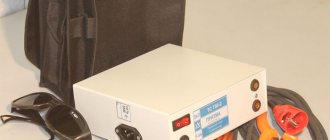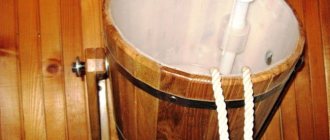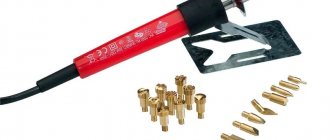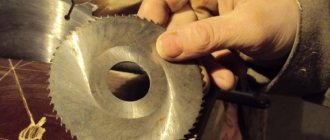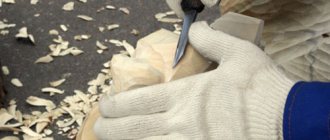Cylindrical leather punches
Professional tools that are used for punching holes in the leather industry or in the saddlery industry, of course, differ from household tools both in their quality characteristics and the strength of the materials used, but a homemade option can also be good.
If you need to make a hole of a large diameter (for eyelets, rivets), you should use a hole punch in the shape of a metal pipe with a sharp edge. It may have a rubber or plastic handle, and you can additionally equip it with a service hole to remove knocked-out leather circles. By choosing different tube diameters from 1.5 to 18.8 millimeters, you can make holes of different sizes.
To make a hole on a leather product, you will need to lay it on a flat, hard surface, make a mark, place the punch vertically, and press the tube with your hand, turning it slightly. As a result, you will get a neat, smooth-edged hole that your cylindrical punch made.
Knife for working with leather with your own hands
A leather cutting knife is a rather unique tool that must meet certain requirements. However, some of the tools we are used to are also suitable for this task. What types of knives are there for cutting, sanding, fleshing and embossing? Let's look at this issue in more detail.
Cutting is a type of leather processing during which the edges are trimmed so that this area can later be used for products.
The name of this word comes from the German “to sharpen”, and this reflects the essence of the operation. During the process of whittling, which is also called sanding, all excess is cut off, and a piece of leather is brought into proper condition.
This operation is an essential part of working with any skin.
The resulting material is most often used to create a pleasant, beautiful and high-quality binding for books, notepads and other similar things.
There are such varieties.
The only problem with such a solution may be very rapid wear of the cutting part. This option is considered unsuitable for full-time work.
If you are working with thick leather and don't want the edges to be rough, you can trim them with a special tool. Of course, it is very sharp on the inside and incredibly thin on the outside.
Externally, this device resembles a tuning fork, since it is represented by two dense parts, the inner surface of which is incredibly sharp.
It is indispensable in the matter of cutting off roughness and unevenness along the edges and therefore is actively used by masters of their craft.
In addition, it can be used to cut the top layers into strips.
In a professional environment, it was designated a tool for lowering the edge.
By the way, there are also serrated discs that allow you to leave holes along the edge of the leather, similar to those left by a sewing machine. It will look aesthetically pleasing and is not difficult to do.
In this case, the master is also ensured safety, because the handle is made in such a way that to access the disk it is necessary to press the lower part of the structure.
However, workers know that after skinning an animal, the material is not immediately ready for use. It still needs to be sharpened and separated from the rest of the skin. And this is exactly where the described device is an assistant.
So, from the above it is clear that a true professional does not make do with a straight razor or a stationery knife.
His arsenal should include a variety of knives that will help him successfully solve various, sometimes very complex, tasks.
Of course, they are unlikely to be useful in the household, but if you decide to seriously take up furriery, then the information gleaned from this article will be useful to you.
For a review of leather knives, see below.
Revolver punch
To make braiding, it is better to use a revolver-type hole punch; you can also make it yourself. In appearance, it is very similar to rings for working with metal, only on its head you will need to place a drum that has 6 sharpened cones of different sizes, from 1.4 to 5 millimeters. In order to make a hole, a piece of leather will need to be inserted between the anvil and the punch, and squeezed with force. This way you will get a hole of the required diameter.
These durable devices can be made from stainless steel with a brass anvil and a compression spring, replaceable steel punches, which have a lifetime warranty. It is only important to take into account the recommendations regarding the thickness of leather products.
FAQ on working with leather for beginners
It’s been almost ten years since I started making leather goods. At that time, there were no lessons or master classes on leather working techniques at all. And even now there are very, very few of them. I also didn’t have any acquaintances knowledgeable in this area, so I had to learn from my mistakes, from articles from the Internet and rather rarely published specialized literature.
Gusarova Maya Nikolaevna.
Where to buy leather?
You can buy leather in specialized leather stores. Most of these stores can be found in the directory in “DoubleGIS” under the heading “Fur/Leather - Raw Materials”. You can often find scraps of leather in various workshops.
How much does leather cost?
Most leather is sold as whole skins. The cost of leather is usually shown per square decimeter.
Pork, calf and goat leather, depending on the thickness, quality and processing features, can cost from 5 to 40 rubles. per square decimeter.
At the beginning of the article, the photograph shows calfskin with the romantic name “Venice”; its cost in leather stores is 25 rubles. per square decimeter.
The skin of various exotic animals: such as snakes, pythons, monitor lizards and so on... can cost from 100 rubles. per square decimeterThe smallest skins have an area of about 40 square decimeters
In the studio, various trimmings can be purchased at a cost of 100-200 rubles. per kilogram.
One kg of scraps is about 50-60 square decimeters in area.
Where to buy leather working tools?
You can purchase many accessories for working with leather at regular hardware stores. Some tools have to be made by hand. Special tools for embossing and more can be purchased in online stores.
How to cut leather?
Knives
To work with leather, it is convenient to use knives with replaceable blades that can be broken off as they wear out. Produces excellent knives and replacement blades. You can buy such knives and blades in construction tool stores, materials stores, repair stores, as well as in specialized online stores
If you cannot find special construction knives, then you can also use ordinary cheap office knives, which you can buy at any office supply store. The only inconvenience of such knives is that you will have to break off the blades more often.
You can also use a shoe knife (in books about working with leather they write about it very often), but it has the disadvantage of requiring frequent sharpening.
You will also need a wide and long metal ruler.
The ruler should be wide in order to protect your fingers from a sharp cutter, namely a metal one, because a wooden ruler will very quickly become unusable. A metal square is also needed.
Leather stepper
If you plan to hand sew parts of a thick leather product, you will need to first punch holes in the leather. A step-by-step hole punch will do the best job for this task. In its shape, it is similar to a fork, the tines of which have a special diamond shape. Just decide in advance on the size of these teeth, and if necessary, place them to the hole at an angle of 45 degrees. With skill, you can not only use a hole punch to mark a line for a straight seam, but even stitch a leather product.
To prepare a leather product for a Mexican braid or braid, you can make a step-by-step hole punch, the teeth of which are arranged diagonally. You can also use it to punch holes in suede and leather, the thickness of which is no more than 5 millimeters.
My leather working tools
Category: Tools Published 08/24/2018 · Comments: 0 · Reading time: 4 min · Views:
It would be wise if I did not mention something from a very new post about extremely minimal tools for working with leather, so as not to repeat myself, but only to complement it.
Line punches
One of the favorite topics of the leatherworking community, and I am also partial to it. Line punches allow you to create even and equally spaced holes in the leather for the future saddle seam. My favorite line punches are from the Taiwanese brand IVAN. The set consists of eleven items. One handle and ten screw-on attachments.
Essentially, these are three sets of punches. Three punches - two, four, six teeth each, repeated three times. The only difference is the distance between the teeth - 2.3 mm, 3.1 mm and 3.9 mm. The teeth themselves, on all ten nozzles, have the same width, and therefore the last, tenth punch is single, suitable for any of the three conditional sets of line punches.
The holes that these punches make are diamond-shaped. Apparently, this is why line punches with this tooth shape are called diamond-shaped.
IVAN are not the only line punches I use, but that's another story.
Saddlery knife
Torbcyl or edge cutter or chamfer cutter
The name itself – “edge cutter” – explains everything. The tool is needed to remove edges from the front edges of the leather. This gives a product made from genuine leather a chic and finished look. The actual processing and painting of the ends of the product is one of the cornerstones of leather craft, and craftsmen pay serious attention to this. In my humble opinion, the torbcile and slicker are one of the most important tools for a leatherworker.
I use two edge cutters, with a cutting blade width of 1.0 and 1.2 mm. I season them with Goya paste as needed.
Needles for sewing leather
The length and shape of the needle, the width of the eye and the features of the point - these are, perhaps, all the characteristics of needles for hand sewing natural leather that may be of interest to a leatherworker.
The most convenient needles for me were five to six cm long and with a fairly wide eye.
Lately I’ve been sewing with blunt-nosed needles, but this is more of a whim than a conscious choice. I recommend buying different ones and trying them out many times.
Drawing rulers for rounding corners
Template of geometric circles with a diameter of 10, 20, 30, 40, 50, 60, 70, 80, 90 mm. Even diameters are located on the inside of the ruler, which is not always convenient for cutting with any kind of knife.
And one more ruler, eight outer circles have a diameter of 5, 7, 10, 12, 14, 16, 20, 22 mm; Inside there are semicircular diameters of 25, 30, 35, 40, 45 mm. Not all of the diameters are useful for leatherworking, but they are available.
As a rule, industrial rulers are made of rather fragile plastic. Leathercraft requires something more durable than plastic stamping. Garage production offers copies of such stainless steel rulers. They are more expensive, but more reliable.
Diamond-point awl
The working part of the awl follows the shape of the diamond-shaped tooth of a line punch, but is much sharper. I use an awl in cases where several layers of leather have not penetrated completely. I have two awls with a diamond-shaped point, with a working surface width of 3 mm and 4 mm for different line punches. I don’t use this awl often, but sometimes it comes in handy.
Tubular punches
A punch in the form of a tube, with a lateral breakdown exit. My set contains nine punches with the following diameters - 2, 3, 4, 5, 6, 8, 9, 10 and 13 mm. I use them to punch holes in leather for fittings and sometimes for some very exotic purposes.
Mallet hammer
I have two mallets and both of them are without any special frills. One with a rubber working surface, weighing 450 grams. The second with a working surface made of some kind of soft polymer, weighing 300 grams. In most cases, I use the second one for work. Sometimes, to punch holes for fittings in thick and dense leather, I use one that weighs 450 grams.
Punch manufacturing options
To make a simple hole punch, you can also use a thin tube with the desired diameter, sharpening its edge. If you need to make not just a round, but a decorative hole in the shape of an oval, crescent or semicircle, you can initially give this shape to the end of your hole punch. Such a tool can be made from an ordinary small screwdriver, an IV needle, or a table fork.
The main thing when making a hole punch for leather with your own hands is to remember that leather is a noble material, but with the necessary skill and accuracy you can make useful, comfortable and beautiful things and accessories from it.
A gentleman's kit for a beginner furrier or basic tools for leather processing 07/30/2019
Tools for working with leather are necessary both for novice lovers of homemade accessories and for larger-scale production related to leather goods.
Some of the tools on sale can be easily replaced with analogues that are found in literally every kitchen, but this option is only acceptable at the stage of amateur furriery. The production of high-quality, high-quality leather goods requires a professional set of tools - the quality of processing with them reaches a completely new level.
Tools for working with leather
Depending on their purpose, leather tools are divided into the following types:
Let's talk in more detail about each of these types of leather processing tools.
Leather Sewing Tools
Tools for sewing leather include the following:
Awl - hand tool for leather
Marking tool
This type of leather processing tool includes a roller and a marking compass. A roller (or wheel basma) is used to carefully mark the distance between stitches. This is done like this: before stitching, the roller is moved along the place where the seam should be.
A marking compass is used to mark the distance from the edge of seams or braids. It is also used when marking the width of the belt during the process of cutting it out. When working with this tool, one end of the compass is pressed against the edge of the leather, the distance is set by adjusting the legs, and with the width set, the other end of the compass is placed on the leather and basted.
Roller for marking leather
How to mark and punch an even seam when sewing leather, see the following video:
Edge finishing tool
Designed for cutting thin strips, triangular in cross-section, from the edges. The edge finishing tool will leave seam- and braid-free edges looking clean and finished.
Beveling knife
If the leather product is cut from loose and not strong enough leather, its edge will be ugly and frayed, and this is when an edge finishing tool will come in handy. It is used like this: the leather is placed face down on the table, and along the wrong side, along the edge of the leather, the tool is advanced, pressing on its cutting blade.
Helpful advice. If you don't have an edge finishing tool at hand, you can simply singe the remaining free edges of the leather over a candle, and this will help give the product a finished look. In this case, try to singe, first of all, the inner edge, and first check the resistance of the skin to fire on a small piece of material.
Knives and scissors for leather
Sanding knives come in crescent or quarter moon shapes. Sanding is the thinning of the edge of the leather, which is necessary for gluing leather goods, shoes and overlapping bindings.
Scissors for working with leather are divided into straight (tailor's) and zigzag scissors.
Zigzag scissors are equipped with cutting surfaces with a serrated pattern and are used to decorate the edges of a product.
Other leather processing tools
When making leather goods, you need more than just knives, awls and edge finishing tools. To ensure that your products are not only of high quality, but also beautiful, you will need tools for leather engraving, leather embossing and other methods of decorative processing of products. Here are the most popular of these tools:
Punchers for leather. They are tools of various shapes and sizes, designed to decorate the edges of products and form a certain relief on them. During operation, the punches are placed vertically on the skin, and then the opposite end is struck forcefully with a regular hammer.
Manual leather punch
Embossing stamps. Leather embossing tool is widely used for finishing leather products. Stamps for leather, in principle, can be made independently from wood (you just need to make sure that the depth of the pattern is at least 1 mm), however, the choice of industrial stamps is unusually large, and the patterns from them are clear and even.
Embossing stamps allow you to create fancy patterns on leather
We invite you to watch an educational video about tools for working with leather, in which you will see the most useful and easy-to-use devices:



